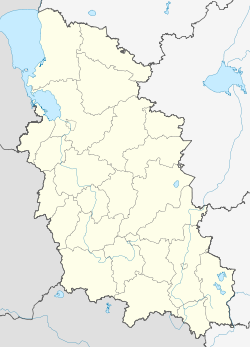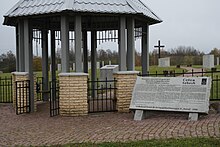Sebesch
| city
Sebezh
Себеж
|
||||||||||||||||||||||||||||||||||||||
|
||||||||||||||||||||||||||||||||||||||
|
||||||||||||||||||||||||||||||||||||||
| List of cities in Russia | ||||||||||||||||||||||||||||||||||||||
Sebesch ( Russian Себеж ) is a small town in the Pskov Oblast ( Russia ) with 6375 inhabitants (as of October 14, 2010).
geography
The city is located about 190 kilometers south of the oblast capital Pskow between the lakes Orono and Sebeschskoje in the catchment area of the Daugava .
Sebesch is the administrative center of the Sebesch Rajon of the same name .
The city lies on the railway line Moscow - Riga opened on this section in 1901 (route km 617). The Sebesch train station is a border station . The city is also on the M9 Moscow - Velikije Luki - Latvian border road (further via Rēzekne to Riga).
history
Sebesch was first mentioned in the chronicles of the Pskov republic as " Pskow suburb", which was destroyed in 1414 by the troops of the Lithuanian Grand Duke Vytautas .
In 1535 a wooden fortress was built on the orders of Prince Shuisky , which was built in honor of John the Baptist (Russian Ioann Predtetscha or Ivan Predtetscha ) Ivangorod-na-Sebesche , d. H. Johannesstadt am Sebeschsee was called. The fortress was an important point of defense on the border with Lithuania and withstood a siege by Polish-Lithuanian troops as early as 1536 . In the will of Ivan the Terrible , the place was mentioned as Sebesch .
From 1579 Sebesch belonged to Poland-Lithuania; Until the beginning of the 18th century, ownership of the city changed several times between Russia and Poland. During the Great Northern War from 1700 to 1721, Sebezh was made one of the main Russian bases on the orders of Peter the Great .
In 1772 the city finally belonged to Russia and received Russian city rights.
During the Second World War , Sebesch was occupied by the German Wehrmacht on July 9, 1941 and liberated on July 17, 1944 by troops of the 2nd Baltic Front of the Red Army as part of the Pskov-Ostrov operation . The German war cemetery at Sebesh is a reminder of this time.
Population development
| year | Residents |
|---|---|
| 1897 | 4,326 |
| 1926 | 5,500 |
| 1939 | 6,049 |
| 1959 | 7,285 |
| 1970 | 10,270 |
| 1979 | 10,783 |
| 1989 | 9,497 |
| 2002 | 7.138 |
| 2010 | 6,375 |
Note: census data (1926 rounded)
Culture and sights
In the historical part of the city, the castle hill with remains of the ramparts from 1535 and an originally Catholic church from 1625, which was restored and re-consecrated in 1990 as the Orthodox Trinity Church ( церковь Святой Троицы / zerkow Swjatoi Troizy), and a bell tower from the 19th century have been preserved .
The city has a local museum and a nature museum.
economy
In Sebezh there are companies in the building materials and timber industry as well as the light and food industries.
sons and daughters of the town
- Witold Rudziński (1913-2004), Polish composer
Individual evidence
- ↑ a b Itogi Vserossijskoj perepisi naselenija 2010 goda. Tom 1. Čislennostʹ i razmeščenie naselenija (Results of the All-Russian Census 2010. Volume 1. Number and distribution of the population). Tables 5 , pp. 12-209; 11 , pp. 312–979 (download from the website of the Federal Service for State Statistics of the Russian Federation)
Web links
- City administration website (Russian)
- Sebesch on mojgorod.ru (Russian)






